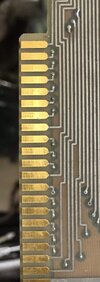Just wanted to put it out there that Burroughs computer cards are close to what is on the original prop in terms of vintage clamp cards. A good thing about them is that 1- They seem to be affordable - 2 - They are common - 3 - They pre date all the original trilogy-
I've been on the search looking at different vintage circuit boards, including the arcade machine boards, and this has been my closest find.
Has the correct board ever been found yet?

\
I've been on the search looking at different vintage circuit boards, including the arcade machine boards, and this has been my closest find.
Has the correct board ever been found yet?
\

